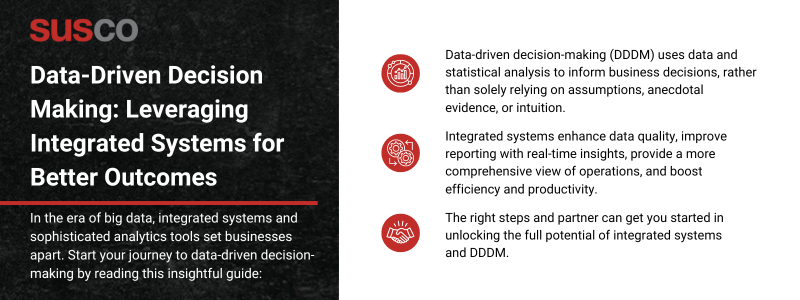In the era of big data, integrated systems and sophisticated analytics tools set businesses apart. Start your journey to data-driven decision-making by reading this insightful guide:

Raise your hand if you’ve ever made a decision based on your “gut” without thoroughly examining the underlying facts. If you’re feeling guilty, don’t. It’s surprisingly common—over 50% of Americans rely on their “gut” when making decisions.
Even in business, companies have imbued intuition with tremendous influence, importance, and prestige—it ranks second to experience when decisions are involved.
This legacy playbook needs a rewrite. While intuition can set you on the right path, it’s often prone to bias and limited scope. Plus, even with experience, it’s hardly enough to keep you competitive in the age of big data.
Today, data-driven decision-making is the ace up the sleeves of the most impactful organizations. A recent PwC report demonstrates that highly data-driven organizations make three times more strategic decisions than their counterparts. Another study by McKinsey suggests that these companies realize 25% more profits.
Fortunately, these game-changing numbers are within your reach. Why? Because your independent adjusting (IA) firm already sits on a treasure trove of data. What’s holding you back from better outcomes is integrated systems. With a custom claims management system (CMS), you can unify functions across the claims process for improved quality, consistency, insights, visibility, efficiency, and productivity.
This guide explores the fundamentals of data-driven decision-making and how to leverage integrated systems for better outcomes. Let’s dive in.
Data-driven decision-making in a nutshell
Data-driven decision-making (DDDM) uses data and statistical analysis to inform business decisions, rather than solely relying on assumptions, anecdotal evidence, or intuition.
The idea is to systematically collect data from disparate sources, leverage analytics to glean meaningful insights, and then use these insights to guide decision-making across different stages of the claims lifecycle.
The key principles of DDDM are:
- Data quality: Accuracy, relevance, integrity, and timeliness drive effective DDDM. If data is flawed, decisions will be too.
- Context: Considering the broader context in which data is collected and used is necessary to ensure regulatory compliance and efficiently meet business objectives.
- Continuous improvement: DDDM isn’t a one-time task but an ongoing process. Regularly revisiting and refining data collection and analysis methods ensures that decisions stay relevant and effective.
By leveraging DDDM, you can:
- Make more confident decisions: Strategic data collection and analysis provide an accurate picture of a decision’s potential impact beforehand, leading to smarter actions. Plus, since data is concrete and logical, you stay objective and eliminate biases.
- Enhance operational efficiency: Comprehensive data analytics uncovers bottlenecks and areas requiring improvement, allowing you to streamline workflows, optimize resource allocation, boost productivity, and save on costs.
- Improve risk management: By leveraging data, you can anticipate and mitigate fraud risks more efficiently and avoid any serious harm to the bottom line.
- Customer satisfaction: DDDM facilitates a faster, more balanced assessment of claims, leading to quick resolution and fair compensation for claimants.
That said, integrated systems are the best way to unlock the full potential of DDDM.
The role of integrated systems in DDDM
1. Enhancing data quality and consistency
Integrated systems consolidate data from all sources, eliminating the discrepancies, duplication, and errors often arising from manual data entry in siloed ecosystems. These systems ensure everyone in the organization works with the same information by providing a single source of truth.
2. Facilitating real-time insights and reporting
Integrated systems provide continuous updates, allowing you to extract insights from data and create reports in real time. This means you can swiftly respond to issues as they emerge. For example, you can reallocate resources promptly when there’s a surge in workload in a certain geographic area or type of claim. You can also quickly spot new fraud patterns and devise a strategy to halt them before any adverse effects.
3. Bringing more visibility into operations
Integration links your CMS, customer relationship management (CRM), financial system, and other critical tools. This makes tracking a claim from initial contact through final settlement a breeze. The end-to-end visibility ensures that nothing falls through the cracks and that every part of the process contributes to a seamless customer experience.
4. Increasing efficiency and productivity
Since integrated systems automatically pull data from different channels and update records, human intervention is minimized, and efficiency and productivity are significantly improved. Plus, organizations achieve greater collaboration, communication, and coordination because information is democratized and accessible to everyone.
Steps to implement integrated systems for DDDM
1. Assessing current systems and data needs
Conduct a thorough audit of your existing technology, data needs, and management practices. Determine which systems are used, how they interact, and where gaps or inefficiencies exist.
2. Choosing the right integration tools and platforms
Look for solutions compatible with your existing technology stack and can scale with your business. Consider factors like cost, ease of implementation, and the level of customization required.
3. Implementing integration strategies
With consultation of all stakeholders, create a detailed implementation plan outlining steps, timeline, and key responsibilities. Ideally, you should first integrate core systems, such as your CMS and CRM, using a phased approach. Remember to test early and often to prevent running into costly issues down the line.
4. Monitoring and optimizing integrated systems
Use your analytics and reporting tools to track key metrics (e.g., average claims processing time and processing costs) and gauge the integration’s effectiveness. Identify areas for improvement and make necessary adjustments.
Data-driven decision-making with Susco Solutions
As you embark on your journey to leverage integrated systems for better outcomes, consider enlisting reliable experts to guide you.
Susco is a leading provider of tailored, cutting-edge technology solutions for IA firms. Our solutions unlock the full potential of data and people, leading to efficiency gains throughout the organization. We can help you build a custom CMS with advanced analytics and reporting capabilities and seamless integration with all your systems.
Start the conversation and propel your move toward a data-driven future.